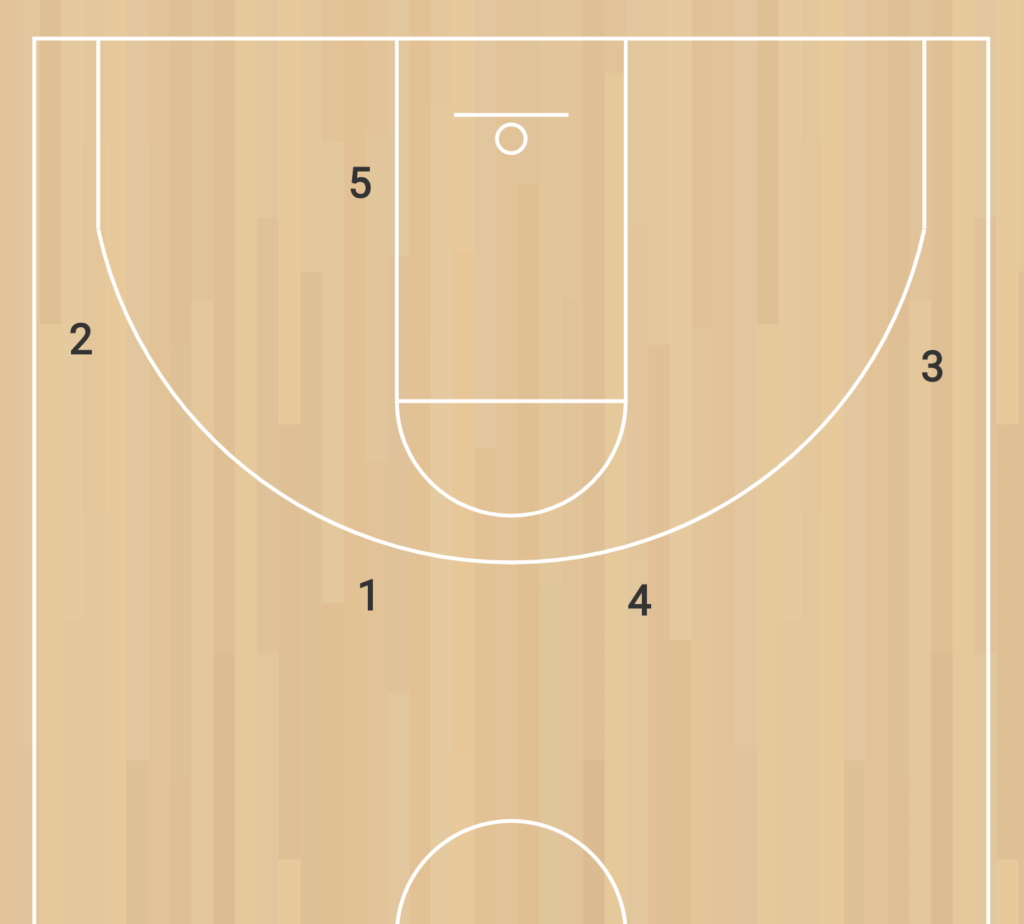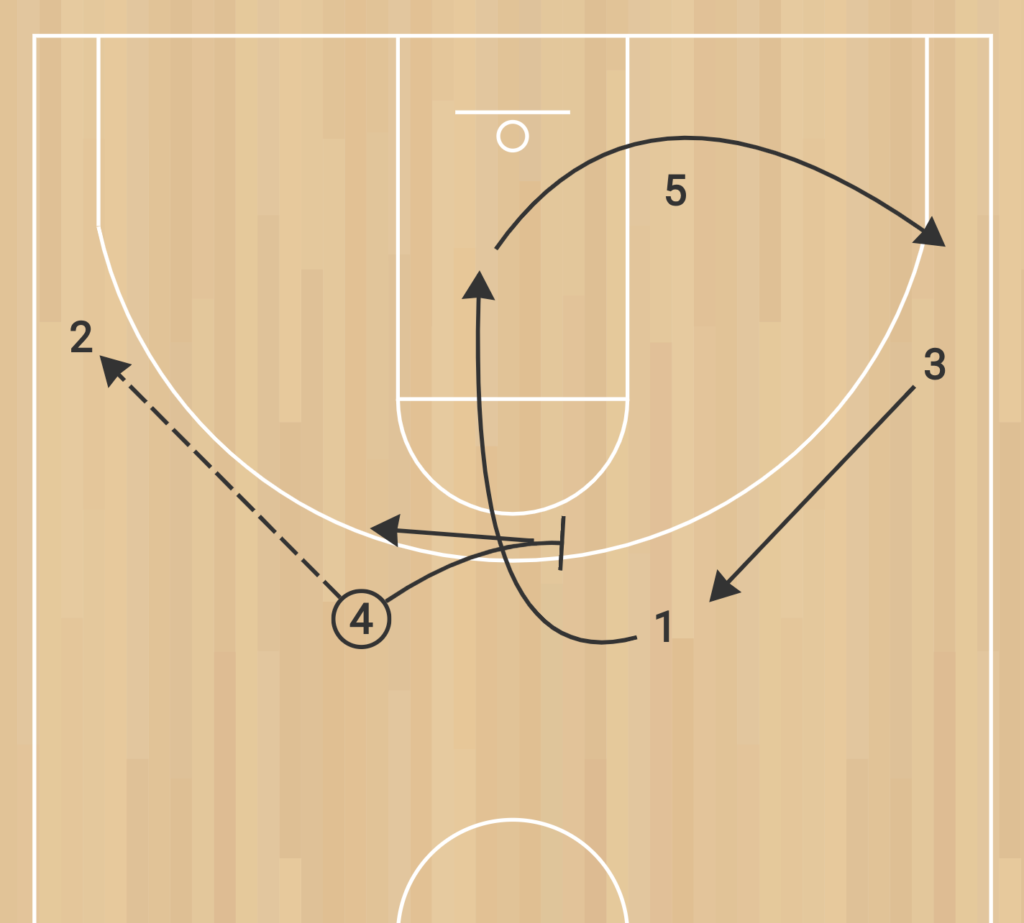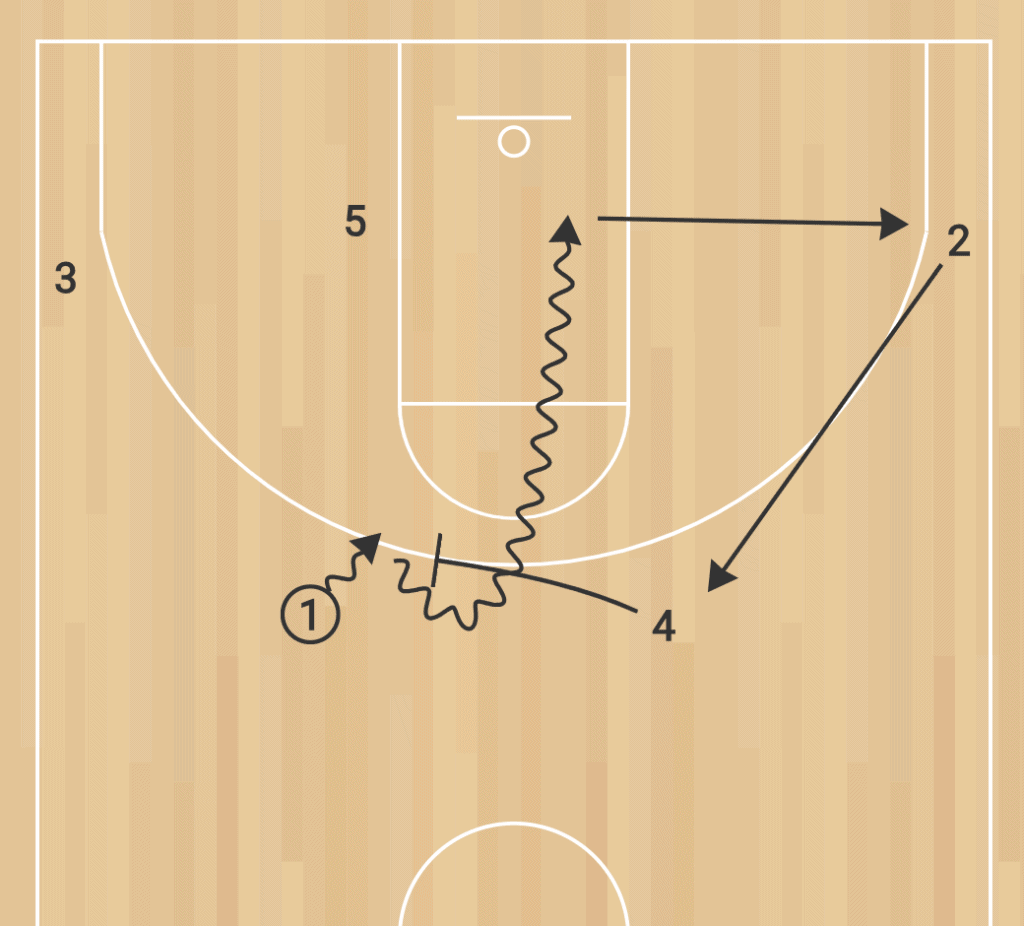When you make a purchase through links on this post, we may earn a commission through Amazon or other retailers. In this case I think it’s just one link to a book about motion offense. Learn more about our affiliate disclaimer.
Alright, the basic concept of the 4 out is super simple, you just space 4 players out around the perimeter with the post down under the basket. And this formation comes up pretty frequently in modern basketball strategy. But the 4 out most commonly referenced as a subset of motion offense, so here we’re going to focus on the 4 out basketball offense as it functions within that context.
You don’t really need to be fully up to speed on every detail of running a motion offense to find value here, but you should at least understand the driving force. A motion offense is designed to promote scoring opportunities.
Sounds like every offense? Well, slightly, but this is a subtle yet elegant twist on traditional strategy. We’ll get into that later though.
So here we’ll look at how the 4-out basketball offense within the context of a motion offense. We’re going to run through the core concepts involved in the 4 out. We’ll also discuss its origins and evolution along with some of it’s more successful applications.
You should come away from this with a basic understanding of 4-out motion offense strategy. But this system comes in a lot of flavors, so if you want to take it to the next level, we’ll finish off with some more comprehensive resources to take your understanding to the next level.
Just what is a 4-out Basketball Offense?
The 4 out basketball offense (as it is most commonly referenced) is a system of movements, originating with a formation placing 4 players around the perimeter and one near the basket, that is designed to generate scoring opportunities efficiently.
Kinda a mouthful. A lot of five dollar words. Let’s try and iron it out a little…
So that term ‘4 out’ is a reference to the theoretical starting positions of this offense system. It’s sometimes referred to as a 4-out, 1-in formation. Seems a little redundant. If 4 are out, it would be weird if the 5th player is also out. Still, that part is clear enough.
This ‘4-out’ configuration pops up in all kinds of strategies though. It’s even sometimes used to describe entire classes of basketball offense. You will occasionally see the Princeton Offense or the Dribble-Drive Motion Offense categorized broadly as ‘4 out’ offenses.
But when we discuss a ‘4 out basketball offense’, it’s usually as a system within a ‘motion offense‘. The driving concept behind ‘Motion Offense Basketball’ is that you’re not setting a specific attack, you’re generating opportunities to attack. And you’re usually encouraging your whole team to take advantage of those opportunities as they arise.
So we’re looking at a system that initiates with 4 players at the perimeter and focuses on advantageous movements over specific plays. That’s a decent place to start. To add to our understanding, we’re going to have to dig deeper into execution.
Executing the 4-Out Basketball Offense
The details of any offensive framework will always end up getting stretched to fit the team, sometimes to the point of being nearly unidentifiable. And even if you were to build your entire playbook around a 4-out concept, you’d have no problem exploring tweaks and adjustments for years to come.
But we can still discuss some of the movements that set the traditional expectations of this system.
The 4-Out Initial Formation
We already mentioned that the 4-out starts with 4 players spaced evenly around the arc. Let’s get a little more specific…

Send your center (5) to the block. Your Power Forward (4) should line up to the elbow opposite the center (5). The point guard (1) would then be balanced opposite the 4 at the top of the arc. Your wings (2 and 3) fill out the spacing.
To build on our understanding of how this system functions in principle, we’ll zoom in on some of the classic 4-out movements. Remember, the central concept here is that we want to use screens and cuts to get one of your players open for a clean shot.
Let’s take a look…
Post Screen Away
The diagram below is a little more complex than I typically like to get into, but I think it says a lot. You might need to just stare at it for a moment and let it sink in…

So what’s going on here?
Well, to start, (4) enters with the ball and kicks it out to the wing. They then move to set a screen for (1) in the opposite slot. After that, they jump back to their slot to maintain that 4-out spacing.
Accepting the screen, (1) cuts for the basket. (3) cuts up to the slot and fills the empty space in the alignment as (1) continues their cut along the baseline and takes the corner that (3) has just surrendered. (1) and (3) are effectively switching places here.
You can see how this has some potential to open scoring options. As the guard cuts down the lane off the screen, (2) may spot the connection for a layup. If (4) shakes a defender in the shuffle, they’re well-positioned for a catch-and-shoot or a pass back to reset the flow.
Notice that once the motion is complete, the formation is reset. You can now flow straight into the next attack. And that’s really the beauty of all of these movements. Once your team is caught up on the program, you can run through these systems as fast as your players can handle it.
Post Screen on Ball

This one is a little simpler. And I don’t know about you, but there’s something about this that looks like every Warriors play ever.
Steph comes in, doubles back for a quick screen off of Draymond. Maybe he shoots if he shakes his defender, or maybe he charges the rack. Klay is probably off in a corner if he needs to kick it out. And whoever happens to be their big at the time is making space in the paint. If things don’t work out, just reset the whole system.
You should be starting to get the point here, beginning to visualize your own twists on the pattern. Run your screens, get your players opened, and if they still have the ball at the end of the cycle, start over.
We could go all day with this stuff, but there are plenty of resources if you’re just looking for 4-out plays. ‘Complete Guide to Motion Offense‘ is a helpful book. Its got a ton of drills and that’s probably the route I’d go if you’re trying to implement a motion offense yourself.
Player Roles in the 4-out Offense
Motion strategies like the 4-out are less focused on specific roles than your typical offensive basketball framework. As your team begins to move on the court, they should be prepared to shift between roles fluidly.
Still, there are some helpful guidelines we can point to.
Your post player is probably the player who fills the most traditional role. With a 4-out, they should be hanging out on the low block. In standard fashion, there job is to take up space in the paint, fighting for position. But even the post can be expected to take uncharacteristic positions.
As the 4-out initiates, your point guard and power forward will slide into the slots. The way your remaining players react will be dependent on which slot gets filled.
When possible, the 4 should approach opposite the center. That is, if your center is on a block, the power forward should approach the opposite elbow.
As your guard or your power forward drive into the lane, the corresponding wing should fill their missing space along the perimeter, resetting the offense. For this reason, your 4 perimeter players should be prepared to assume any roles and initiate the next offensive cycle.
The Advantages and Disadvantages of the 4-Out
Before we get into the details, let’s cover the positives and negatives of the 4-out offense. Understanding where this strategy might come in handy tends to help add a little context when you zoom in on the implementation.
Advantages
- Spacing the court to give defenders more ground to patrol.
- Generates open shots for the entire team.
- Allows players more time to make decisions with the ball.
- Makes it tougher to double-team, or trap.
- If penetration fails, just return to it instead of having to pass back to the (1) to reset.
Disadvantages
- Can lead to turnovers if not run correctly.
- You need a versatile post player.
- Runners may have difficulty getting open shots.
- Players all need to learn to read and react effectively.
So again, this is a strategy that is very inclusive, but it does require some skill and practice to perform it effectively and consistently. If you’re in a position where you simply want to win, and you aren’t prepared to spend months studying and refining your plays, this is probably not the strategy for you.
The History of the 4 Out in Basketball
Most of the core motion offense systems go back to Bobby Knight. You’ve probably heard of him. The iconic and volatile college coach who is deeply entwined in the evolution of modern basketball strategy.
He was friends with Princeton’s Pete Carill and the motion offense systems take some obvious cues from Carill’s infamous Princeton Offense. Knight took the Hoosiers to 3 NCAA Championship titles during his tenure.
The 4 out and motion offense systems in general are as popular as ever, having played a significant role in the dominant Warriors dynasty. With some of the NBA’s most successful teams employing the strategy, the 4 out basketball offense has become a staple of modern basketball and is used by many teams in the NBA and at the collegiate level.
4-Out Offensive Drills
Mikan Drills
When is this not a good drill? If you’ve never heard of the Mikan, it’s just active and intense layup practice. And it’s one of the most beloved basketball drills of all time. I recommend it to anyone and everyone looking to improve their skills.
Stand under the basket. Pound a dribble to the left and turn it into a layup. Reset, then pound it to the right for another layup. Pull a layup off a jump from your inner foot, then one from your outer foot. Use your left hand on the right side, then your right hand on the left side.
None of this needs to follow a strict pattern. Just keep attacking the basket and getting better and better at your approach to scoring from 0 range. Deep shooting is a valuable threat in the 4 out, but a cold post game is going o make the difference.
How to Defend Against a 4 Out Offense
Understand the Offense
Study the 4-out and understand the details of its execution. You have to understand your opponent if you’re going to take them apart. Few practices are more beneficial to a defense than simple and deliberate scrimmaging against a reasonable approximation of your opponents offense. Run a scrimmage and shut it down at any time to run through counters to successful scoring attempts.
Contain the Ball
Try to keep the ball on one side of the court. Shutting down ball movement, particularly ball reversal, can help to limit the effectiveness of your opponents cuts and screens. Easier said than done. Still worth focusing on.
Pressure the Perimeter
Defenders should be actively looking to close out on shooters, making it difficult for them to get open shots. Look to double team players that are driving to the basket.
Focus on Help Defense
Lock down the weak side. Communication is key and each defender should be aware of where help is coming from in order to prevent easy baskets. Rotate quickly and be prepared to switch on screens.
Defeat the Screens
This may be the true achilles of the 4 out if you can pull it off. Crush those screens. If you can get around the screens effectively, you’ve eliminated a crucial element of this offense.
Takeaways
The 4-out is as good a place as any to start building a motion offense. It is only one of the traditional motion systems, but there’s a simplicity to the 4-out that lends itself to clarity.
It’s not a Swiss Army Knife. It’s not going to get you out of every situation you get yourself into. But it’s a fun offense that gets the ball moving and it can be quite easily tweaked and expanded without limit.
The 4-Out is also a fantastic option if you’re looking to be inclusive. It’s a great option for youth teams because it allows you to keep your players engaged while building the core skills and concepts of competitive basketball.
If executed correctly, a 4 out basketball offense can be a very effective offensive system.
